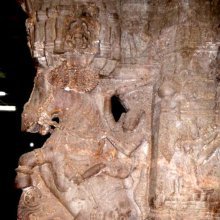Arala, Arāla: 15 definitions
Introduction:
Arala means something in Hinduism, Sanskrit, Marathi, Hindi. If you want to know the exact meaning, history, etymology or English translation of this term then check out the descriptions on this page. Add your comment or reference to a book if you want to contribute to this summary article.
Alternative spellings of this word include Aral.
Images (photo gallery)
In Hinduism
Natyashastra (theatrics and dramaturgy)
Source: Wisdom Library: Nāṭya-śāstraArāla (अराल, “bent”) refers to a gesture (āṅgika) made with a ‘single hand’ (asaṃyuta), according to the Nāṭyaśāstra chapter 8. The hands (hasta) form a part of the human body which represents one of the six major limbs (aṅga) used in dramatic performance. With these limbs are made the various gestures (āṅgika), which form a part of the histrionic representation (abhinaya).
Source: archive.org: The mirror of gesture (abhinaya-darpana)One of the Twenty-eight Single Hands (hasta):—Arāla (bent): the first finger of the Patāka hand is curved. Usage: drinking poison, nectar, etc., or sharp acid.
According to another book: the thumb and forefinger of the Patāka hand are curved. It was first used by Agastya in drinking (āpośanam-kṛte) the seven seas. Its colour is red, its racemixed, its patron deity Vāsudeva—such is its history accordingto Bharata and others. Usage: the sipping of water (āpośana) by Brāhmaṇas, benediction, the aversion of a parasite (viṭā) for his friend, dressing the hair, saying “Come soon!”, circumambulation at morning and evening prayer, wiping sweat from the brow, putting collyrium on the eyes, etc.
Source: archive.org: Natya ShastraArala (अरल, “bent”).—A type of gesture (āṅgika) made with a single hand (asaṃyuta-hasta);—(Instructions): The forefinger curved like a bow, the thumb also curved and the remaining fingers separated and turned upwards.
(Uses): With this should be represented courage, pride, prowess, beauty, contentment, heavenly [objects], poise, act of blessing and other favourable states. And this, again, will represent woman’s gathering of hairs or scattering them and looking carefully over their entire body. The preliminaries to the marriage by bride’s going round the bridegroom[21] and [marital] union[22] are to be represented by two Arāla hands moving around each other and their fingers meeting in the form of a Svastika.

Natyashastra (नाट्यशास्त्र, nāṭyaśāstra) refers to both the ancient Indian tradition (shastra) of performing arts, (natya—theatrics, drama, dance, music), as well as the name of a Sanskrit work dealing with these subjects. It also teaches the rules for composing Dramatic plays (nataka), construction and performance of Theater, and Poetic works (kavya).
Shaivism (Shaiva philosophy)
Source: SOAS University of London: Protective Rites in the Netra TantraArāla (अराल) refers to “curved (talons)”, according to the Netratantra of Kṣemarāja: a Śaiva text from the 9th century in which Śiva (Bhairava) teaches Pārvatī topics such as metaphysics, cosmology, and soteriology.—Accordingly, [verse 10.7cd-17ab, while describing the worship of Bhairavī and Bhairava]—“[Bhairavī] has the appearance of vermillion or lac. [She has] erect hair, a large body and is dreadful and very terrifying. [She has the medicinal plant] śatavārī, is five-faced, and adorned with three eyes. [Her hands bear] curved talons (nakha-arālā) curved [She has] eyes like the hollow of a tree and wears a garland of severed heads. [Ten-]armed, like Bhairava [she also] bears Bhairava’s weapons [of an axe and hatched]. [...]”.

Shaiva (शैव, śaiva) or Shaivism (śaivism) represents a tradition of Hinduism worshiping Shiva as the supreme being. Closely related to Shaktism, Shaiva literature includes a range of scriptures, including Tantras, while the root of this tradition may be traced back to the ancient Vedas.
Languages of India and abroad
Marathi-English dictionary
Source: DDSA: The Molesworth Marathi and English Dictionaryaraḷa (अरळ).—a or, by redup., araḷataraḷa a Loose and slovenly--a truss, bundle, or any package or binding: irregularly fixed; not right, true, square--a stone, post, beam: vague or indefinite--speech: disorderly or slack--proceedings, business. 2 (For aruvāḷa or र) Light and crumbling--cakes &c.
--- OR ---
araḷa (अरळ).—ad or, by redup., araḷataraḷa ad Loosely, slackly, slovenlily, disorderly (with verbs of tying, fastening, binding): also untruly or unsquare--planting, setting, fixing: also loosely or roomily; not pressingly or compactly--piling or placing: also laxly, vaguely, indefinitely, immethodically--speaking or performing.
Marathi is an Indo-European language having over 70 million native speakers people in (predominantly) Maharashtra India. Marathi, like many other Indo-Aryan languages, evolved from early forms of Prakrit, which itself is a subset of Sanskrit, one of the most ancient languages of the world.
Sanskrit dictionary
Source: DDSA: The practical Sanskrit-English dictionaryArāla (अराल).—a. [ṛ-vic araṃ ālāti, lā ka] Spreading like the spokes of a wheel, curved, crooked; 'अरालः कुटिले मतः इति (arālaḥ kuṭile mataḥ iti)' मेदिनीकरः (medinīkaraḥ); Mālatīmādhava (Bombay) 9.34; पादावरालाङ्गुली (pādāvarālāṅgulī) M.2.3.
-laḥ 1 A bent or crooked arm.
2) The resin of the plant Shorea Robusta (sarjarasa; Mar. rāḷa).
3) An elephant in rut.
-lā 1 An unchaste woman, harlot, courtezan.
2) A modest woman (adhṛṣṭā).
Source: Cologne Digital Sanskrit Dictionaries: Shabda-Sagara Sanskrit-English DictionaryArāla (अराल).—mfn.
(-laḥ-lā-laṃ) Crooked. m.
(-laḥ) 1. Resin. 2. An elephant in rut. 3. A bent or crooked arm. f.
(-lā) 1. A modest woman. 2. A disloyal or unchaste one. E. ara what goes. ā before lā to take or give, and ka aff.
Source: Cologne Digital Sanskrit Dictionaries: Benfey Sanskrit-English DictionaryArāla (अराल).—adj., f. lā, Crooked, [Rāmāyaṇa] 5, 28. 13.
Source: Cologne Digital Sanskrit Dictionaries: Cappeller Sanskrit-English DictionaryArāla (अराल).—[adjective] crooked, bowed, curled (hair); [masculine] a kind of resin.
Source: Cologne Digital Sanskrit Dictionaries: Monier-Williams Sanskrit-English Dictionary1) Arāla (अराल):—mfn. (cf. ara, [from] √ṛ; [Intensive] for arāra?), crooked, curved, [Uttararāma-carita] (an- [negative] ‘straight’), etc.
2) crisped or curled (as hair), [Raghuvaṃśa] etc.
3) ([gana] śārṅgaravādi q.v.) ‘Crispus’, Name of a Vedic teacher, [Vaṃśa-brāhmaṇa]
4) m. a bent or crooked arm or hand, [cf. Lexicographers, esp. such as amarasiṃha, halāyudha, hemacandra, etc.]
5) the resin of the plant Shorea Robusta, [cf. Lexicographers, esp. such as amarasiṃha, halāyudha, hemacandra, etc.]
6) m. an elephant in rut, [cf. Lexicographers, esp. such as amarasiṃha, halāyudha, hemacandra, etc.]
7) Arālā (अराला):—[from arāla] f. ([gana] bahv-ādi q.v.) a disloyal or unchaste woman, [cf. Lexicographers, esp. such as amarasiṃha, halāyudha, hemacandra, etc.]
8) [v.s. ...] a modest woman, [cf. Lexicographers, esp. such as amarasiṃha, halāyudha, hemacandra, etc.]
9) Ārāla (आराल):—mfn. ([gana] tārakādi, [Pāṇini 5-2, 36]), a little curved or crooked, [Tārānātha tarkavācaspati’s Vācaspatyam, Sanskrit dictionary] (?)
Source: Cologne Digital Sanskrit Dictionaries: Yates Sanskrit-English DictionaryArāla (अराल):—[a-rāla] (laḥ) a. Crooked. m. Resin; elephant in rut; a bent arm. (lā) f. A chaste or unchaste woman.
[Sanskrit to German]
Sanskrit, also spelled संस्कृतम् (saṃskṛtam), is an ancient language of India commonly seen as the grandmother of the Indo-European language family (even English!). Closely allied with Prakrit and Pali, Sanskrit is more exhaustive in both grammar and terms and has the most extensive collection of literature in the world, greatly surpassing its sister-languages Greek and Latin.
Hindi dictionary
Source: DDSA: A practical Hindi-English dictionaryArāla (अराल) [Also spelled aral]:—(a) bent, slanting; crooked.
...
Kannada-English dictionary
Source: Alar: Kannada-English corpusArāla (ಅರಾಲ):—
1) [adjective] made curved or crooked; bent; not straight.
2) [adjective] textured close; woven firmly together.
--- OR ---
Arāla (ಅರಾಲ):—
1) [noun] the tree Shorea robusta ( = S. talura, - Vatica robusta) of Dipterocarpaceae family; the Sal tree.
2) [noun] the resinous exudation of this tree.
3) [noun] (dance) a single hand-gesture, in which the forefinger is curved like a bow, the thumb also curved and the other fingers are kept one behind the other.
--- OR ---
Arāḷa (ಅರಾಳ):—[noun] = ಅರಾಲ [arala]2.
--- OR ---
Arāḷa (ಅರಾಳ):—
1) [noun] an elephant in rut.
2) [noun] a class of elephants (classified on their physical size and strength).
Kannada is a Dravidian language (as opposed to the Indo-European language family) mainly spoken in the southwestern region of India.
See also (Relevant definitions)
Starts with: Arala-katakamukam, Aralahasta, Aralai, Aralaicaralai, Aralakatakamukha, Aralakeshi, Aralakhatakamukha, Aralakhatakamukhahasta, Aralalar, Aralam, Aralamba, Aralambu, Aralan, Aralapakshman, Aralapakshmanayana, Aralapodeya, Aralasarala.
Ends with (+95): Agarala, Ahigarala, Aisarala, Akarala, Akaralavikarala, Anarala, Antahsarala, Antarala, Aralasarala, Atitarala, Attanayakarala, Aysarala, Barala, Battanarala, Batwadanarala, Belmarala, Bhagarala, Bharala, Bharala Bharala, Bhugarala.
Full-text (+30): Aralika, Aralita, Aralakeshi, Aralahasta, Arala-katakamukam, Rala, Utsanga, Arihala, Aralapakshmanayana, Saptapatala, Vayu, Koyashtika, Aralakatakamukha, Kokila, Bhimarathi, Aral, Drinking, Heavy storm, Storm, Aralapakshman.
Relevant text
Search found 9 books and stories containing Arala, A-rala, A-rāla, Arāla, Araḷa, Arālā, Ārāla, Arāḷa; (plurals include: Aralas, ralas, rālas, Arālas, Araḷas, Arālās, Ārālas, Arāḷas). You can also click to the full overview containing English textual excerpts. Below are direct links for the most relevant articles:
Abhinaya-darpana (English) (by Ananda Coomaraswamy)
Chapter 27 - Hands denoting Flying Creatures
Chapter 14 - Twenty-six Combined Hands
The history of Andhra country (1000 AD - 1500 AD) (by Yashoda Devi)
Part 6 - The Kona Kandravadis < [Chapter IX - The Kandravadis (A.D. 1130-1280)]
Natyashastra (English) (by Bharata-muni)
Chapter IX - Gestures of Major Limbs (aṅga)
Chapter XXVI - Varied Representation (citrābhinaya)
Vishnudharmottara Purana (Art and Architecture) (by Bhagyashree Sarma)
2.2. Hand Postures (a): Asaṃyukta-hasta < [Chapter 3 - Drama and Dance]
2. The Viṣṇudharmottara-purāṇa and the Indian Classical Dances < [Chapter 6 - Modern Relevance of Different Art Forms and Architecture]
2.2. Hand Postures (b): Saṃyukta-hasta < [Chapter 3 - Drama and Dance]
Elephantology and its Ancient Sanskrit Sources (by Geetha N.)
Matangalila and Hastyayurveda (study) (by Chandrima Das)
Measurement and Age of the Elephants < [Chapter 3]

